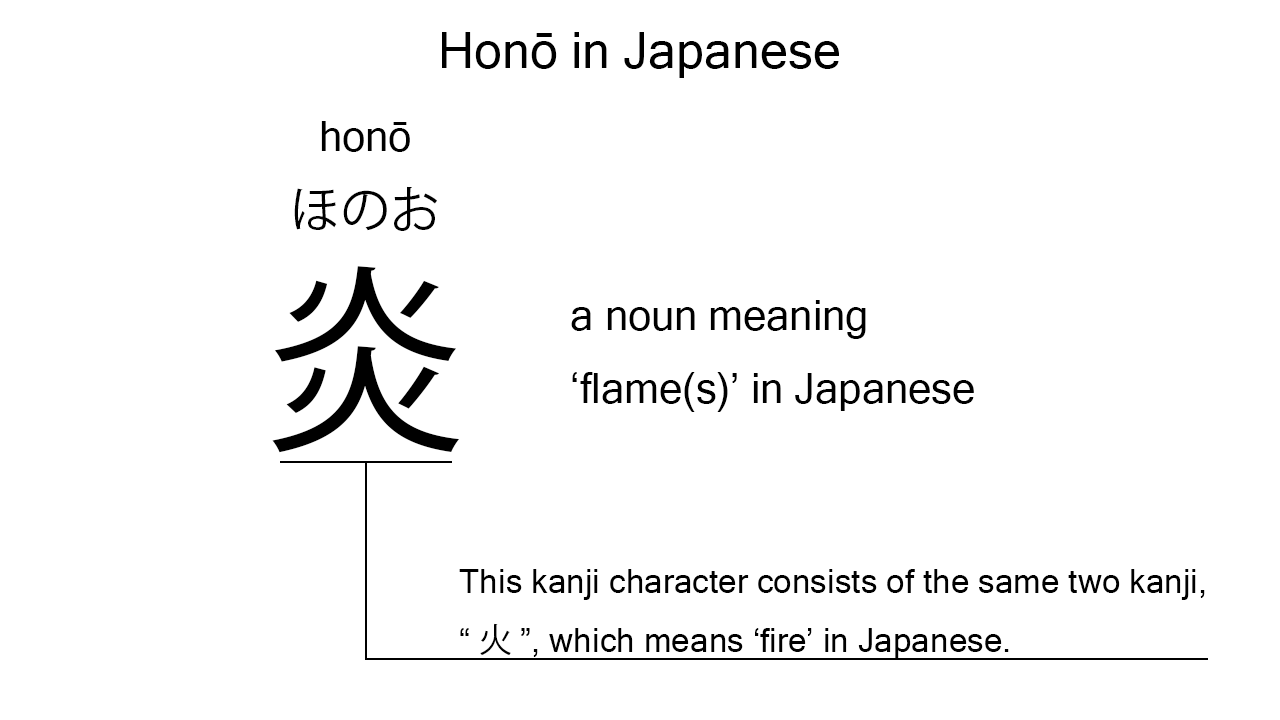What does “honō” mean in Japanese?
Native speakers say “honō” to mean ‘flame’ in Japanese. Perhaps, some Japanese learners know this word as it is sometimes used in Japanese movies, songs, novels, manga, anime, and the like. In this blog post, however, I will explain this word in detail based on its kanji character. And also, I will explain how to use it through example sentences. My explanations would help Japanese learners understand “honō” more clearly. Then, let’s get started!
Contents
Definition and meanings of “honō”
Let me start with the definition and meanings of “honō”.
- honō – 炎 (ほのお) : a noun meaning ‘flame’ or ‘blaze’ in Japanese. This can also work as plural. Learn more about Japanese plural.
The definition and meanings are simple and clear, I think. To understand this noun more clearly, however, let me explain its kanji character in detail.
Honō in kanji
The kanji character of “honō” consists of the same two kanji:
- 火 : a kanji character widely used to mean ‘fire’ in Japanese.
From this kanji character, we can understand that the formed kanji character literally means ‘fire on fire’ in Japanese. This literal interpretation is not completely in line with the actual meanings, but still understandable, I think. A flame is normally the top part of a fire.

When we meet new kanji characters, we should check their parts in detail to understand their meanings clearly and deeply. In many cases, kanji parts tell us a lot about the meanings of the characters they form. Actually, here, we could get the better understanding of “honō” through the detailed kanji check above.
So far, I’ve explained the definition and meanings of “honō” together with its kanji character. Then, let me explain how to use it through the example sentences below.
Example #1: how to say “flame” in Japanese
ore tachi wa aoi honō wo mi ta – 俺達は青い炎を見た (おれたちはあおいほのおをみた)
We saw a blue flame.
Below are the new words used in the example sentence.
- ore – 俺 (おれ) : a pronoun meaning ‘I’ rudely in Japanese.
- tachi – 達 (たち) : a suffix used after a noun or pronoun to make its plural form. In the example, this is used after “ore” to make its plural form, “ore tachi”, which means ‘we’ in Japanese.
- wa – は : a binding particle working as a case marker or topic marker. In the example, this works after “ore tachi” to make the subject in the sentence.
- aoi – 青い (あおい) : an i-adjective meaning ‘blue’ in Japanese.
- wo – を : a case particle used to make the object word in a sentence. In the example, this is used after “aoi honō” to make the object in the sentence.
- mi – 見 (み) : one conjugation of the verb, “miru“, which means ‘to see’ in Japanese. In the example, it has been conjugated for the better connection with its following word.
- ta – た : an auxiliary verb used after a verb, adjective, or auxiliary verb to make its past tense form. In the example, this is used after “mi” to make its past tense form, “mi ta”.
This is a typical usage of “honō”. In this example, it works as a part of the noun phrase, “aoi honō”, which means ‘a blue flame’ in Japanese.
Example #2: another usage of “honō”
honō wa mada chiisakat ta – 炎はまだ小さかった (ほのおはまだちいさかった)
The flame was still small.
Below are the new words used in the example sentence.
- mada – まだ : an adverb meaning ‘still’ in Japanese.
- chiisakat – 小さかっ (ちいさかっ) : one conjugation of the i-adjective, “chiisai“, which means ‘small’ in Japanese. In the example, it has been conjugated for the better connection with its following word.
This is another typical usage of “honō”. In this example, it works together with the binding particle, “wa”, to become the subject in the sentence. When we want to say “flame” in Japanese, anyway, this noun is always a very good option.
Summary
In this blog post, I’ve explained the definition and meanings of “honō” in detail based on their kanji character. And also, I’ve explained how to use it through the example sentences. Let me summarize them as follows.
- honō – 炎 (ほのお) : a noun meaning ‘flame’ or ‘blaze’ in Japanese. This can also work as plural. This kanji character literally means ‘fire on fire’ in Japanese. This literal interpretation is not completely in line with the actual meanings, but still understandable, I think. A flame is normally the top part of a fire.
Hope my explanations are understandable and helpful for Japanese learners.